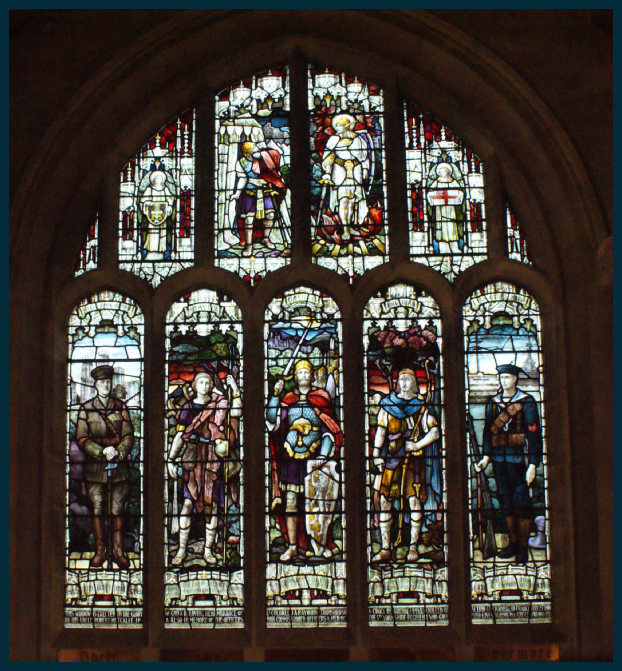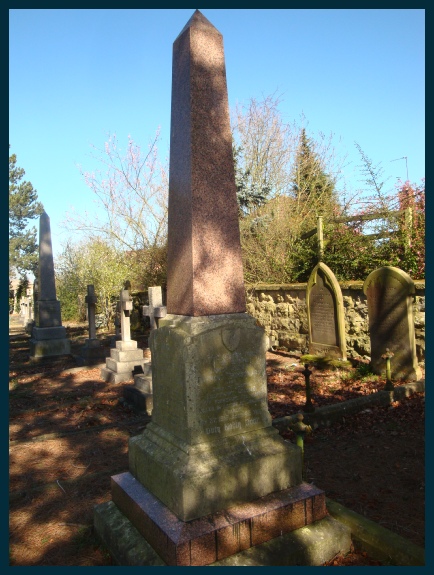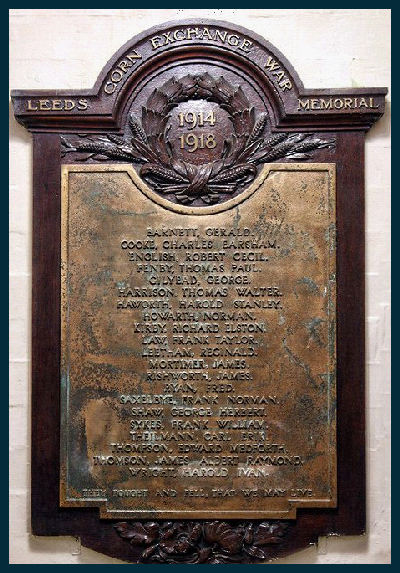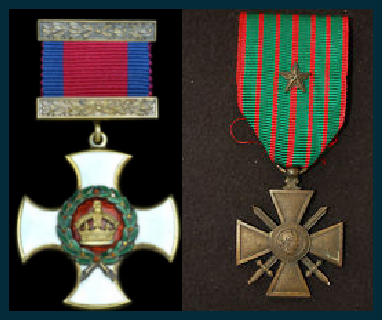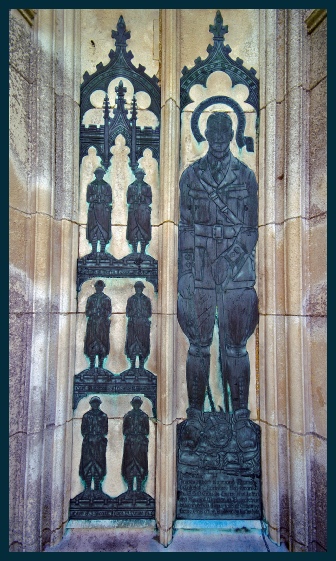Copyright © All rights reserved.



Raymond Thomson
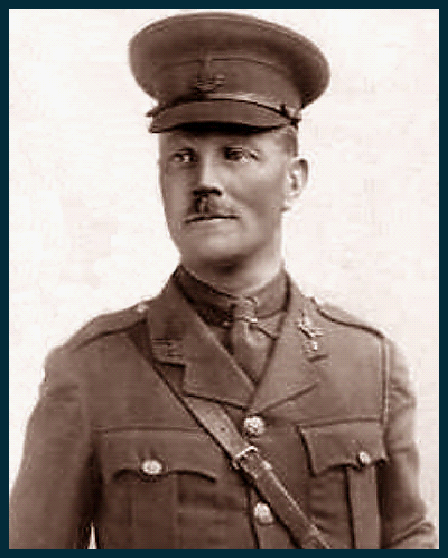
James Albert Raymond Thomson was born in Huddersfield on 18th February 1876 and was baptised on 23rd March in Highfield Independent Chapel in Huddersfield. He was the son of James and Eliza Jane (nee Metcalfe) Thomson who married at St Leonard’s Church, Malton on 20 February 1867. Eliza was the daughter of William and Elizabeth Metcalfe – William was a prosperous Corn and Coal merchant living on what is now Castlegate (then Low Street) – they later moved to Rockingham House -
James and Eliza came to live in Huddersfield in the quiet, residential district of Regent Road, Edgerton. . The house was named "Leonard Place", and there, three children were born to them. Florence Edith, on April 28th 1868, was followed in the autumn of the next year by Blanche, and after a gap of seven years the only son, James Albert Raymond, was born. This was where they were living at the time of the 1881 census.
1881 Census – resident at Leonard Place, Regents Rd Edgerton, Huddersfield
THOMSON, James, Head, Married, M, 39, Commercial Traveller, Glasgow Scotland,
THOMSON, Eliza J, Wife, Married, F, 37, , Malton Yorkshire,
THOMSON, Florence E, Daughter, Single, F, 12, Scholar, Huddersfield Yorkshire,
THOMSON, Blanche, Daughter, Single, F, 11, Scholar, Huddersfield Yorkshire,
THOMSON, James A R, Son, Single, M, 5, Scholar, Huddersfield Yorkshire,
LINALLEY, Helen, Servant, Single, F, 24, Dom Servant General, Newcastle Northumberland,
BRAUN, Pheobe, Servant, Single, F, 16, Nurse Housemaid, Burslem Staffordshire,
At a later period, James built a fine new house in Park Drive, called "Mount Royd", and numbered 13! It was large and spacious. To the right of the square hall was a pleasant morning room, dominated by an enormous mahogany bookcase filled with books of tooled leather, of glowing colours and gold lettering, which looked handsome and splendid. The dining room was large and well-
1891 Census – resident at Royal Medical Benevolent College, Epsom Surrey
THOMSON, Raymond, Pupil, , M, 15, Huddersfield
By 1901 James Albert Raymond Thomson was working in Huddersfield but appears to have been living in Malton as the Census finds him in the household of his maternal uncle Robert Metcalfe. N.B. It was Robert Metcalfe who put up the stained-
1901 Census – resident at West Royd, Castle Howard Road, Malton
METCALFE, Robert, Head, Married, M, 58, Grain Merchant, Malton Yorkshire,
METCALFE, Frances, Wife, Married, F, 48, , Paddington London,
THOMPSON, James A R, Nephew, Single, M, 25, Grain Merchant, Huddersfield Yorkshire,
BLACKBURN, Rebecca, Servant, Single, F, 20, Cook Domestic, Malton Yorkshire,
HARPER, Maud Elizth, Servant, Single, F, 20, Housemaid Domestic, Scagglethorpe Yorkshire,
In 1901 Raymond was gazetted as Second Lieutenant in the 2nd Volunteer Battalion of the Yorkshire Regiment , and was promoted to Lieutenant in 1903.
In the second quarter of 1905 he married Ethel Norah Mayson Johnson in York. Ethel, who was the daughter of Edward Mayson Johnson, an ale and Porter merchant living in St Marygate, York who had died in 1887, was baptised in St Olave’s Church, York on 19th October 1878. Later that year he was promoted to Captain in the Yorkshire regiment .
The 1911 census shows them living at “The Uplands” on Middlecave Road in Malton, the house now occupied by Malton Montessori School and in 1912 the 5th Volunteer Battalion of the Yorkshire regiment to which Raymond had been transferred became part of the Territorial Force Reserve and he was confirmed as Captain.
1911 Census – resident at The Uplands, Middlecave Road, Malton
THOMSON, James Albert Raymond, Head, , M, 34, Flour Miller And Corn Merchant, Yorks Huddersfield,
THOMSON, Ethel Mayson, Wife, Married 6 years, F, 31, , York St Olaves,
SCUHAM, Elenar, Servant, Single, F, 27, Cook Domestic, York Malton,
PRINGLE, Margaret, Servant, Single, F, 31, Housemaid Domestic, Durham Houghton Le Spring,
His niece gives an account of the declaration of war in 1914:
“Daddy beckoned the boy over to buy a paper, his look grave and preoccupied, and almost snatching it he turned to the huge headlines across the front page. "So," said Daddy, "it has come."
War! What, I wondered, would that mean? I thought of the old wars of the history books, the arrows, boiling oil, and later cannon balls, any of which would be dreadful to encounter. But those were all outdated long ago, big guns taking the place of the little cannons we sometimes saw placed for decoration on terraces and steps. I wondered afresh what war could mean.
Little did any of us then know what a modern war entailed, how frightful would be the bloodshed, and how long the strain on those left at home. Little did the gallant youths know what was ahead of them as they rushed forward to volunteer, filled simply with a sense of adventure and a stirring of patriotism, many adding years to their ages just to be in at the battle.
As a family, we were not surprised as were so many others that England and Germany were at war, for Uncle Raymond, Mummy's only brother, was a Captain in the Territorial Army and he had told Daddy for some time that he was sure it would come. He and Auntie Ethel had only recently returned from a holiday in Germany and it had been made very plain to them how the Germans felt, many actually spitting at them, so that they were disgusted and heartily glad to be back in their own country. “
Shortly before the war, owing to pressure of business Raymond was placed on the Reserve Force but as soon as war was declared he rejoined his old regiment, then based at Hull and it was there that he took the Yorkshires’ first prisoners of war at Hull in 1914 whilst in charge of interned German shipping.
In 1915 the Battalion became part of 150th Brigade, 50th (Northumbrian) Division. In early April the Division was warned that it would go on overseas service and entrainment began on 16 April, landing at Boulogne.
Raymond was in charge of the advance party who left Newcastle on April 15th and arrived in France on the morning of 17th April. On the 18th they were joined by the rest of the Battalion and after less than 24 hours in Camp were entrained, arriving at Cassels at 6.0 am and marched twelve ‘hot and very tiring’ miles to billets outside the village of Steenvoorde, where they finally rested, for three whole days. On the 23rd they were on the move again, proceeding by Motor Buses to Vlamertinghe and from thence marched to A Huts at Ypres arriving just as the German army had attacked at Ypres, using poison gas for the first time. ‘As they tramped along the pave road, with Vlamertinghe and Ypres ahead, the boom of guns became even louder. Crowds of refugees were met, hurrying westwards with handcarts perambulators and almost any kind of vehicle laden with all the worldly possessions left to them.’ That night they moved forward to the banks of the Yser Canal in support of 2nd Zouaves. The Battalion lined the Canal banks under the shelter of a ridge before daylight, the men shortly afterwards digging themselves into shelter holes. B Company, which was somewhat exposed, suffered minor casualties from overdropping bullets.
That morning they had their first experience of shell fire, but over the next few days were fully involved in the chaos of the Battle of Ypres and sustained heavy casualties – a true baptism of fire, and Captain Thomson had his first experience of writing letters of condolence to the families of his men.
In May the battalion was moved to an open field in Brielen where they dug in and companies were rotated to Sanctuary Wood and Zouave Wood where they came under gas attack as well as shelling, continuing to sustain losses. By the 8th May, the Malton messenger carried an article reporting that in order to enable speedy replacement of casualties sustained by the 4th and 5th Battalions the height requirement had dropped to 5’1”.
The end of June saw them billeted in farms near Dranoutre and in mid-
In December they were moved to Poperinghe, where they went into trenches at Dickiebusch. On 24th December Captain Thomson was wounded. According to the Malton Messenger he was shot in the arm while attending a wounded man.
The same pattern of rotation between trenches, dug-
“I am sorry to tell you that Capt. Thomson has been wounded again. Being the only Maltonian present at the time, I feel I cannot help telling you how bravely the Captain stuck to his post, until he was wounded, during a heavy retaliation from the Germans on our trench. It had been arranged to blow up an enemy bombing post at 4.30 on the morning of March 2nd and the Battalion stood by in case the Germans ventured an attack. The morning was dark and not a sound could be heard except the crack of a rifle and a bomb now and then. The stated time arrived and the mine was blown up, creating a vast cloud of smoke and making the earth shake all round. At once the artillery opened out, combined with rapid fire, bombs, trench mortars, rifle fire, grenades etc. to which the Germans replied – having got the wind up – in similar fashion. In two minutes the quiet morning was turned into an absolute hell; trench mortars and “Sausages” etc. were falling all round within a few feet of our dug-
The people of Malton cannot think too much of him, for he is due to all respect, being a soldier and a man throughout. He is admired by every officer and man in the regiment for his gentle manner and thought towards his men, having earned the respect of all. My only hope is he gets safely home. He has been through it all and done his duty”
For most of the rest of 1916 the same pattern continued – it is not recorded when Captain Thomson returned from hospital but presumably he was back in camp with his battalion in December when he was gazetted as temporary Major on 12th December. The battalion as at this time training at Baizieux Camp.
In January 1917 they were back in the front line at Mametz in the Flers sector and as the Germans withdrew to the Hindenburg Line at the end of February they were marched up to Arras. At the end of March Major Thomson took command of 5th Battalion and that month’s war diary is filled in in his neat and methodical handwriting. April saw them on the front line and on 23rd they were engaged in heavy fighting which saw them sustain heavy casualties with 18 killed and 180 wounded or missing. May was uneventful, consisting mainly of marching and training, but they were back at the front in June and July, with Major Thomson again taking over command during the latter half of July. August and September continued the same pattern. In August his rank was consolidated and in September he was promoted to acting Lt-
In October, the battalion was moved to the Ypres Salient and after a period of training found themselves again on the front line, sustaining heavy losses at the end of the month. This pattern continued in November, with a carefully structured training programme of fitness, musketry, specialist disciplines (gas, bombing etc) and of course drill. December saw them alternating between support and frontline, continuing to lose men both to enemy action and disease. January saw them alternating support and training before a return to the front line in February.
The battalion fought rearguard actions during the German spring offensive in March 1918 and on the 25th of the month the GOC 24th Brigade sent for the newly promoted Lt Col Thomson to thank him for the efforts made by the officers and men of the battalion during the German onslaught.
The Russian Revolution and that country's subsequent withdrawal from the War in the East had allowed the Germans to transfer troops to the Western Front. On the 21st of March 1918 they were ready to launch 76 Divisions against the 28 of the Allies along a 50 mile Front in the St Quentin area, presumably to split the British and French Armies, capture the Channel ports and thus cut off the British Army and prevent further landings. The news that America had belatedly entered the War meant they had to take decisive action before they were outnumbered.
The 5th Yorkshire Battalion were thrown right into the centre of this onslaught. Each side would lose around a quarter of a million men. The War Diary gives a flavour of the mayhem that ensued, along with Col. Thomson’s clear exasperation with his superiors.
On 26th March at about 8.00 am enemy appeared and firing ensued. Contradictory orders made the withdrawal of the 150th Composite Battalion very difficult and the whole of rearguard platoon of 5th Yorks was either killed or captured. The retirement was carried out through Vermande Villers where Battalions reorganised On 27th the night passed quietly except for enemy Artillery which was in action during the greater part of the night. Casualties in this position were caused by their own Artillery.
Col Wilkinson was here wounded and Col Thomson assumed Command of 150th Infantry Brigade Unit. The enemy launched an attack at about 7.00 pm, but were driven back with heavy casualties.
At about midnight B.G.C. gave verbal orders directly to Col Thomson at the latter’s HQ to withdraw to trenches immediately in rear of present position At 4.30 am, Col Thomson was sent for by BGC 24th Infantry Brigade, who was holding a conference of COs. No definite orders were given except to withdraw leaving initiative in hands of Battalion Commanders, but the 150th Infantry Battalion was to act as rearguard to the 6 DLI. On arrival the formation of troops assumed an extraordinary aspect, due to orders given by B.G.C. Col Thomson consequently again reported to BGC and asked for definite orders as he was not satisfied with the position taken up. Gen Haig said position had so altered that he was at a loss to decide on course to be pursued, but that Col Thomson had better take up a position on high ground South of Caix and cover withdrawal of troops in front.
Here at about 11.00 am 150th Battalion unit linked up with 8th DLI on Right and Right again the Col Thomson then gave orders for 150th Battalion to withdraw through Caix and proceed down the Caix-
In Beaucourt village Col Thomson met General Staff Officer 1 of 8th Division and reported as to the orders received. This Officer said some of the orders had been cancelled, some battalions going in another direction, but Lt Col Thomson had better proceed according to his orders, as he did not believe in altering them.
Outside Moreuil [at about 7.30 pm] Lt Col Thomson was met by 149th Infantry Brigade Transport Officer [Clayton] who halted them and stated that General Officer Commanding 50th Division wishes the Division to be fed. This was done and gave satisfaction to all ranks.
At about 8.30 the Battalion proceeded into Moreuil, where Col Duke met Col Thomson and gave orders to proceed to Louvrechy where billets would be found for the night.
This village contained a number of French troops, but billets were eventually found about midnight.
On the 29th at 7.30 am an order was received by Col Thomson stating that he should proceed immediately to the wood 1 mile South of Demuin. The Battalion moved at 8.45 from Louvrechy arriving at about 11.30 am, where Col Thomson reported to BGC 149th Infantry Brigade.
The Battalion took up a position in the wood from the road Northwards and dug themselves in.
At about 5.30 pm, the enemy penetrated the copse immediately North of Villers aux Erables and the village itself. At about 6.00 pm the Right flank gave and Gen Riddell ordered Col Thomson to launch an immediate counter attack. 1 Coy, 4th East Yorks and 1 Coy 5th Yorks were ordered to attack and hold the copse above mentioned. They were formed up and were just about to move to the attack when the troops on Right completely fell back under orders of their G.O.C. The counter attack was immediately cancelled by Col Thomson, who reported the change in the situation to General Riddell and received orders from him to withdraw the troops and also those remaining in the wood and on the East side of it to a point on the Amiens-
Col Thomson took up HQ with Gen Riddell in Quarry on main road due South of G. in Hourges. Here Gen Riddell was relieved at about 9 pm by Col Irwin commanding 5th Northumberland Fus, and Brigade HQ was established in a house at East end of village of Hourges.
At about 7.00 am on 30th orders were received from Brigade Major 60th Infantry Brigade that as the enemy was holding the wood North of Moreuil, Lt Col Thomson must establish a Standing Patrol of 1 Officer and 20 ORs to guard his Right Flank, and that in the event of a withdrawal, the Composite Battalion would take up a position and fight a rearguard action to cover the safe withdrawal.
Owing to his being hit, Lt Col Thomson withdrew to Brigade HQ [149] at Hourges and handed over Command to Capt Pollock, 4th East Yorks. (This wound was evidently reasonably slight as he was able to sign off this account in the war diary!)
About 8.30. am orders to withdraw were given by 60th Infantry Brigade and the line moved back to the Hourges side of the wood directly South East of Hourges.
At 7.00 pm the 150th Infantry Brigade unit in conjunction with the French on Right counter attacked and re-
The next night was quiet but at about 2.00 p.m the enemy attacked on a frontage extending beyond both flanks of 150th frontage. Capt Pollock and his party fought till the last moment and inflicted heavy casualties on the enemy.
Over these 6 days, the Battalion sustained 372 wounded or missing and 24 dead.
On April 1st the 3rd Cavalry Division made a successful attack on the ridge and woods South East of the River de Luce. At 6.00 pm the Brigade was treated as having been relieved and marched to Longeau and billeted there on the night. The following day they marched to Saleux and went by train to Rue, and marched to rest billets, rejoining their Units.
As the German offensive on the Somme ground to a halt on the 5/6th April another opened on the Front between Ypres and Bethune and within days the 5th Battalion, exhausted and with many raw recruits were back facing the Storm troopers. On the 9th they arrived at the town of Estaires, finding it heavily shelled and the main street impassable. They moved forward in support of 4 East Yorks in touch with 4th Yorks on Left, but not in touch with 5th DLI on Right. “A” Company was sent forward and filled the gap, linking with 4th East Yorks on Left and 5th DLI on Right.
Next day orders were received to move up at once in support to 4th Yorks. The Battn moved at once and was in position astride the road at 6,30 am. At about 11.00 a.m information was received that the enemy having crossed the River Lys at Bac St Maur was then occupying La Boudrelle. 3 Companies were immediately sent forward to form a defensive flank and came under direct and heavy Machine Gun and Light Field Artillery fire and suffered casualties. During the heavy shelling and confusion a new line had to be established, which was held for the remainder of the day and all night. There was continuous rifle fire and constant demands for small arms ammunition and heavy casualties were undoubtedly inflicted on the enemy.
The next morning the enemy attacked the Left flank heavily. The Middlesex on the Left withdrew, but the 5th Yorkshires held on till practically surrounded and many were captured or left wounded, it being impossible to get them away. At 1.00 pm orders from BGC of 150th Infantry Brigade were received from the joint HQ of the 4th and 5th Yorks to form a stragglers post to collect all men of the 150th Infantry Brigade. Men were collected and the 150th Infantry Brigade formed a Battalion under Lt Col Thomson, though a very weak Battalion.
The force collected was instructed to move to Brigade HQ at Vierhouck. At about 6.00 pm the amalgamated Battalion with several stragglers from other Regiments were stopped by a representative from the 150th Infantry Brigade and informed that the enemy were in Neuf Berquin and told to form a parallel to and on the South East side of the road that they were on. This was done, but casualties were severe from a Light Field Gun of the enemy's. Orders from 150th Infantry Brigade received about 7.00 pm instructed the force to hold on till darkness at all costs and then if unable to hold withdraw and move to Vierhouck. At about 8.30 pm the position having become untenable and both flanks being in the air, Col Thomson ordered the Battalion to move as directed and they reported Brigade HQ at about 10.30 pm.
At 5.00 a.m next morning the Battalion was ordered to take up a Line parallel to the road and about 5.45 am, 3rd Coldstream Guards arrived and began to dig in on the line of the road. The enemy advancing caused the line to withdraw on the C Guards. The Battalion was assembled and took up a position on the Right of the Guards, where it linked up with some men of the 7th DLI who then came under Col Thomson's orders. In this position the mixed Battalion held on until about 4.00 pm. At about this hour some detached posts of the Guards were surrounded and had to surrender. This and constant Machine Gun fire and sniping started a withdrawal of the mixed men. These were rallied and reformed but the situation remained obscure with two men dead and 175 wounded or missing.
On the 14th, Working Parties were set to work to dig a Reserve Line. The Battalion was then held for digging purposes, but the tactical position was such that if the enemy broke through, the Battalion would hold the Line they were digging. The Brigade reorganised and each Battalion formed a Coy, the whole 150th Brigade under Col Thomson and two days later the Battalion moved to La Lacque, the Division now being in Corps Reserve and remained at La Laque till the 25th. Next day they marched to Unchair where they stayed training until 7th May when they moved into trenches at Craonne. On 15th they moved into billets at Beaurieux in Divisional Reserve training until 21st when the Battalion moved into trenches and relieved 4th Yorks Battalion. Life in the trenches continued as usual until the night of the 26th when they were"Stood to" owing to information received that enemy attack was to be delivered on morning of 27th May.
The 150th Infantry Brigade was occupying the Plateau de Californie [or Craonne Roads inclusive] and Left to the Piste d'Orleans inclusive. Two Battalions were in the Front line -
Of the Front Line Battalions, the 5th Battalion Yorks on the Right with 3 Companies in Front and one in Reserve, alternated with 4th Battalion Yorks Regt for tour of 6 days. The 4th East Yorks Battalion on the Left remained permanently in the Line on a Single Company Front.
On a warning being received from Division about 4.00 pm of an impending hostile attack, reported by prisoners to be due to open with a 2 or 3 hours bombardment at 1.00 am on the 27th, the Reserve Company of the 4th East Yorks was moved from La Hutte to PC Verdun [in Craonne] and placed at the disposal of 5th Yorks and the Support Company of the 4th East Yorks moved into close support. The 4th Yorks Battalion was released from Div Reserve and placed at the disposal of the Brigade.
Col. Thomson was buried in an anonymous grave as an unnamed British Soldier together with two other members of the 5th Yorkshires. In 1920 their remains were exhumed as part of the concentration procedure whereby the fallen were gathered into the large and well-
He is also commemorated on an obelisk monument in New Malton cemetery.
Col. Thomson is also commemorated on the Sledmere Cross close to the home of his former commanding officer, Sir Mark Sykes.
He is also recorded on the War Memorial in Leeds Corn Exchange as one of the fallen members of the corn exchange and men who worked in the building.
As well as being commemorated in St Leonard’s Church, Col. Thomson also features on the town War Memorial and on the War Memorial in St Michael’s, Malton
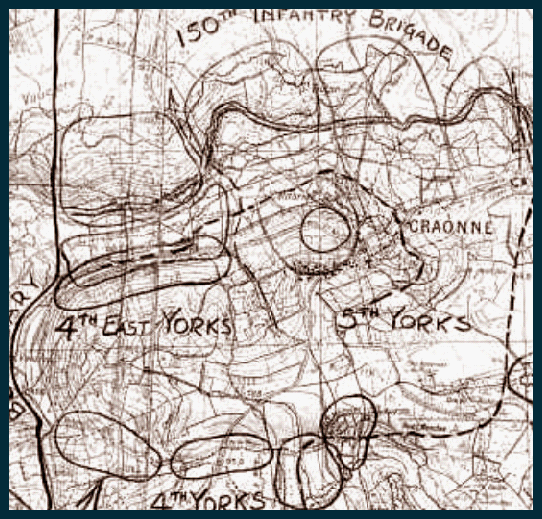
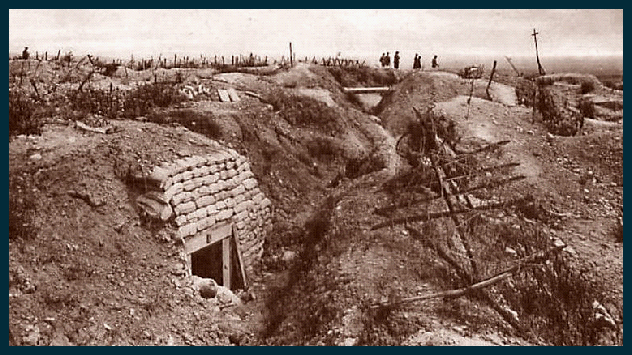
On the 27th the Enemy attacked at 4.30 am. Barrage commenced at 1.00 am.
The casualties of this attack were frightful – nine men were known to have been killed and twelve wounded. However 25 Officers and 638 other ranks were missing, the majority of whom later proved to have been killed.
The 5th Yorks Battn was positioned to the right of the 4th East Yorks Battn, with 3 Companies occupying the front line and one in Reserve. Its HQ was in Craonne under Lt Col J A R Thomson.
As news came in of an iminent German attack a Reserve Company of the 4th East Yorks was placed at his disposal.
The opening German bombardment at 1 a.m on Californie Plateau obliterated the front line trenches and the duguouts of the Battalion. Communications with neighbouring Units were lost and contact with Brigade HQ remained only for a short time.
They were attacked on both flanks at 4.30 by German Units. An attempt to drive the Germans from the plateau was made by the Reserve D Company and the Company of East Yorks, but failed with heavy casualties. At the same time Brigadier General Rees ordered a Company of 4th Yorks, under Captain A L Goring, to attack the flank of the enemy. This attack failed under the tremendous barrage of shell fire which was falling around the Brigade HQ. Rees ordered the remnants of the 5th Yorks to try and break through to the Rear, but few managed to make it. By 6-
After fighting to the last he ran for it and was killed in action on the 27th May 1918 aged 42. Conan-
By the end of May no senior Officer was left to complete the War Diary and only the Divisional version exists.
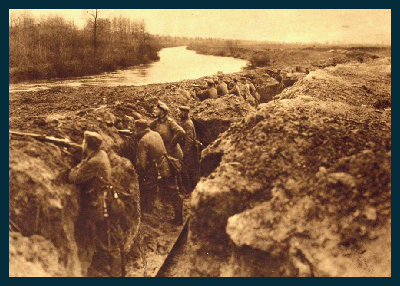
“Harassing fire had been carried out during the early part of the night by our Artillery and Machine guns, on the enemy approaches, upon abnormal activity being notices during the evening of the 26th. At 1.00 am the bombardment opened with all nature of shell, including gas. Brigade HQ in particular was shelled inconsistently with gas and masks had to be worn outside the gas-
The bombardment was the heaviest yet experienced and heavy casualties were caused in the forward posts on the Plateau. No Infantry attack developed against the Brigade front from the North, but as a result of the successful advance made by the enemy on the Right position of the Divisional Frond and through the 22nd French Division on the Left, the Plateau was enveloped on both flanks by about 6.30 am. The hostile barrage was maintained on the Plateau itself to the last. It is feared that many men were captured in the deep dug outs before they were able to come out. The Observation Posts on the Plateau had been unable to report the progress of events owing to the smoke and dust.
There was no morning mist. The buried cables to Right Battalion held and Lt Col Thomson reported about 5.45 am that his HQ Company were then fighting around his Command Post and that they appeared to be surrounded. No news was received from the 4th East Yorks, very few of whose men came back, but it is probable that they were overwhelmed about the same time.
The Brigadier General Commanding decided, in view of the general advance being made by the enemy along the whole front, that no counter-
About 7.00 am the Brigade HQ left La Hutte with the intention of re-
The Brigade HQ ceased to exist temporarily and was not reformed until the arrival of the Division at Vert La Gravelle on the 31st May.
On June 8th, the Malton Messenger reported that Lieutenant-
A fortnight later the Messenger reported the official “Gazetting” of Col. Thomson’s D.S.O. which had been awarded as a result of the actions in March 1918 “Lieut-
On December 14th the Messenger finally announced Col. Thomson’s death:
“MALTON’S GREAT LOSS – Death of Lt.-
Universal regret will be felt at the news that Lieut.-
Malton and district have shared the anxiety of his relatives since May 27th, when the news came through that he was missing, and now that he is gone the neighbourhood mourns him and reveres his memory. Eulogistic remarks are unnecessary, for to know him was to love him, and his character may be summed up in the phrase “an officer and a gentleman”. Respected and beloved by all, he had not a single enemy, either in civilian life or in the Army.
Lieut.-
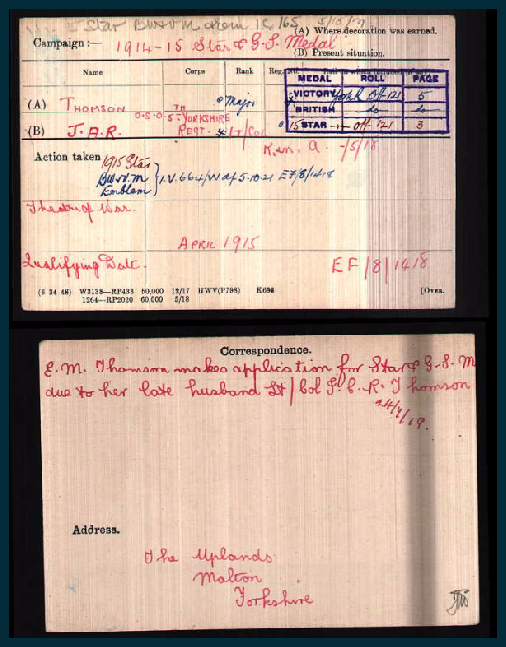
With the commencement of hostilities, Col. Thomson was one of the first to respond to the call and April 1915 saw him in France with the regiment he loved so well, participating in the glorious stand which the 5th Yorkshires made when they stemmed the rush of the Germans, and earned the praise of Sir John French. Two years later he was promoted to the rank of Major, and some short time later, on the death in action of Lieut.-
In private life, Col. Thomson was equally well respected. He took a keen interest in the town in which he lived, and had he been spared would have played a prominent part in the future management of Malton. He was a director of the Malton Gas Company and as everyone knows was a keen supporter of the Malton Horse Procession Society, and on several occasions acted as steward at the annual processions.
Deceased was educated at Epsom College, and was a nephew of Alderman R. Metcalfe, who brought him up, and to whom he was almost more than a son in loving devotion.
By the death of Col. Thomson Malton has suffered an irreparable loss, and his memory will be held in reverence for generations to come. The greatest sympathy is shown on all hands to Mrs Thomson on the sad and tragic fate which has befallen her husband, also to Alderman R. Metcalfe and their greatest consolation will be embodied in the words “Duty nobly done.”
On Sunday 19th January 1919 a Memorial Service was held at St Michael’s Church for Col. Thomson reported by the Messenger the following Saturday:
One of the largest attended memorial services ever held in Malton was that at St Michael’s Church on Sunday afternoon for the late Lieut.-
Long before 3 p.m. the church was filled and many people were standing in the aisles. The congregation, numbering nearly a thousand people, was thoroughly representative in character, all the trades, professions and associations with which the deceased was connected being represented, including both men and women who have lost their sons in the great war – indeed all classes of society were fully represented.
The Rev. W. Ingham, assisted by the Vicar, the Rev. H.L. Ogle conducted the service, which was very impressive. It opened with the hymn “Brief life is here our portion” and was followed by sentences from the Burial Service and the xci Psalm. The lesson 2 Sam. i. 17-
…The procession from the Drill Hall consisted of men from the 5th Yorkshire regiment, many of whom had served since 1914, and included also many returned prisoners of war and discharged and wounded men, ex-
In June 1919 the memorial window in St Leonard’s Church funded by Col. Thomson’s uncle Robert Metcalfe in memory of his nephew and all those of the 5th Yorkshires who had died during the war, was unveiled by Lieut.-
The Hon. Tatton Willoughby. Col. Thomson’s niece Vivian Hirst records “Great-
The idea was entirely Great-
The window was unveiled with the words, "In neverdying honour of the Officers, Non-
All through the War Daddy had written long, affectionate letters to Uncle; he had a warm regard and hero-
The Messenger carried a long article describing the window in detail and recording the sermon preached by the Vicar of Malton, the Rev. H.L. Ogle in full. The church was packed for the service, and afterwards Mrs Thomson entertained The officers and men of the 5th Yorkshires, together with their wives and the families of those who had fallen, to tea in the Drill Hall.
